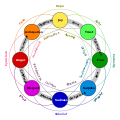This article is missing information about the causes of confusion that are not related to pharmacology.(April 2025) |
| Confusion | |
|---|---|
| Specialty | Psychology, psychiatry |
| Part of a series on |
| Emotions |
|---|
  |
In psychology, confusion is the quality or emotional state of being bewildered or unclear. The term "acute mental confusion" [1] is often used interchangeably with delirium [2] in the International Statistical Classification of Diseases and Related Health Problems and the Medical Subject Headings publications to describe the pathology. These refer to the loss of orientation, or the ability to place oneself correctly in the world by time, location and personal identity. Mental confusion is sometimes accompanied by disordered consciousness (the loss of linear thinking) and memory loss (the inability to correctly recall previous events or learn new material). [3]